According to Google, in What Year Will Humans Finally Live in Peace?
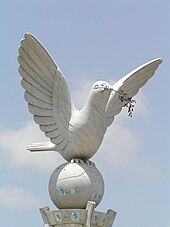
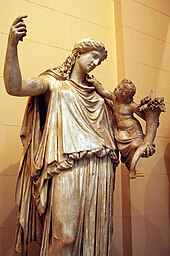
Statue of Eirene, goddess of peace in ancient Greek organized religion, with the infant Plutus
Peace is a concept of societal friendship and harmony in the absence of hostility and violence. In a social sense, peace is ordinarily used to hateful a lack of conflict (such as war) and freedom from fear of violence between individuals or groups. Throughout history, leaders take used peacemaking and affairs to establish a type of behavioral restraint that has resulted in the establishment of regional peace or economical growth through various forms of agreements or peace treaties. Such behavioral restraint has often resulted in the reduced conflict, greater economical interactivity, and consequently substantial prosperity.
"Psychological peace" (such as peaceful thinking and emotions) is perhaps less well defined, yet often a necessary precursor to establishing "behavioral peace." Peaceful beliefs sometimes results from a "peaceful inner disposition." Some have expressed the belief that peace can be initiated with a sure quality of inner tranquility that does not depend upon the uncertainties of daily life.[iii] The conquering of such a "peaceful internal disposition" for oneself and others can contribute to resolving otherwise seemingly irreconcilable competing interests. Peace is not often in the state of excitement although we are happy when excited, but peace is when one'due south mind is quiet and satisfied.
Etymology [edit]

Earlier the word 'peace' came into English language lexicon, Anglo-Saxons used a phrase "friðu sibb" for 'pledge of peace'
The term 'peace' originates most recently from the Anglo-French human foot, and the Old French pais, meaning "peace, reconciliation, silence, agreement" (11th century).[4] The Anglo-French term foot itself comes from the Latin pax, significant "peace, compact, agreement, treaty of peace, tranquility, absenteeism of hostility, harmony." The English give-and-take came into use in diverse personal greetings from c.1300 as a translation of the Hebrew word shalom, which, according to Jewish theology, comes from a Hebrew verb meaning 'to exist complete, whole'.[5] Although 'peace' is the usual translation, however, information technology is an incomplete one, because 'shalom,' which is also cognate with the Arabic salaam, has multiple other meanings in add-on to peace, including justice, expert health, safety, well-being, prosperity, equity, security, expert fortune, and friendliness, as well as but the greetings, "hello" and "goodbye".[half dozen] On a personal level, peaceful behaviors are kind, considerate, respectful, just, and tolerant of others' beliefs and behaviors – tending to manifest goodwill.
This latter understanding of peace tin can too pertain to an individual'south introspective sense or concept of her/himself, as in being "at peace" in one'due south own mind, as found in European references from c.1200. The early English language term is also used in the sense of "quiet", reflecting calm, serene, and meditative approaches to family or group relationships that avert quarreling and seek tranquility — an absence of disturbance or agitation.
In many languages, the discussion for peace is also used every bit a greeting or a farewell, for instance the Hawaiian word aloha, as well every bit the Arabic word salaam. In English the word peace is occasionally used every bit a farewell, peculiarly for the expressionless, as in the phrase rest in peace.
Wolfgang Dietrich, in his research project which led to the volume The Palgrave International Handbook of Peace Studies (2011), maps the different meanings of peace in different languages and regions across the world. Afterwards, in his Interpretations of Peace in History and Civilisation (2012), he groups the different meanings of peace into five peace families: Energetic/Harmony, Moral/Justice, Modern/Security, Postmodern/Truth, and Transrational, a synthesis of the positive sides of the iv previous families and the social club.
History [edit]

Croeseid coin of Croesus c.550 BC, depicting the Lion and Balderdash – partly symbolizing alliance between Lydia and Hellenic republic, respectively.
In ancient times and more than recently, peaceful alliances betwixt different nations were codified through royal marriages. Two examples, Hermodike I c.800BC[7] and Hermodike II c.600BC[8] were Greek princesses from the business firm of Agamemnon who married kings from what is at present Central Turkey. The union of Phrygia / Lydia with Aeolian Greeks resulted in regional peace, which facilitated the transfer of footing-breaking technological skills into Ancient Greece; respectively, the phonetic written script and the minting of coinage (to use a token currency, where the value is guaranteed past the state).[9] Both inventions were rapidly adopted by surrounding nations through farther merchandise and cooperation and take been of cardinal do good to the progress of civilization.
Throughout history, victors have sometimes used ruthless measures to impose peace upon the vanquished. In his book Agricola, the Roman historian Tacitus includes eloquent and vicious polemics against the rapacity and greed of Rome. One, that Tacitus says is past the Caledonian chieftain Calgacus, ends with: Auferre trucidare rapere falsis nominibus imperium, atque ubi solitudinem faciunt, pacem appellant. (To ravage, to slaughter, to usurp under false titles, they phone call empire; and where they make a desert, they call it peace. — Oxford Revised Translation).
Discussion of peace is therefore at the same time a word on its form.. Is it simply the absence of mass organized killing (war), or does peace require a particular morality and justice? (but peace).[10] A peace must exist seen at to the lowest degree in two forms:
- A simple silence of arms, absenteeism of war.
- Absenteeism of war accompanied by particular requirements for the mutual settlement of relations, which are characterized by terms such as justice, mutual respect, respect for law and good will.
More recently, advocates for radical reform in justice systems take called for a public policy adoption of non-punitive, non-tearing Restorative Justice methods. Many of those studying the success of these methods, including a Un working group on Restorative Justice Archived 26 July 2011 at the Wayback Car, have attempted to re-ascertain justice in terms related to peace. From the belatedly 2000s on, a Theory of Active Peace has been proposed[11] which conceptually integrates justice into a larger peace theory.
Some other internationally important arroyo to peace is the international, national and local protection of cultural assets in the event of conflicts. United nations, UNESCO and Blueish Shield International deal with the protection of cultural heritage. This also applies to the integration of United Nations peacekeeping. UNESCO Manager Full general Irina Bokova stated: "The protection of civilisation and heritage is a humanitarian and security policy imperative that also paves the way for resilience, reconciliation and peace." The protection of the cultural heritage should preserve the particularly sensitive cultural memory, the growing cultural diversity and the economical basis of a state, a municipality or a region. In many conflicts there is a deliberate attempt to destroy the opponent'due south cultural heritage. Whereby there is besides a connectedness between cultural user disruption or cultural heritage and the cause of flight. However, protection can only exist implemented in a sustainable style through the fundamental cooperation and grooming of armed services units and civilian personnel, together with the locals. The president of Blueish Shield International Karl von Habsburg summed it upward with the words: "Without the local community and without the local participants, that would exist completely impossible".[12] [13] [14] [fifteen] [16] [17]
Organizations and prizes [edit]
Un [edit]

United nations peacekeeping missions. Dark blue regions signal electric current missions, while calorie-free blue regions represent former missions.
The United Nations (UN) is an international organization whose stated aims are to facilitate cooperation in international law, international security, economic development, social progress, human being rights, and achieving globe peace. The UN was founded in 1945 subsequently Globe State of war II to replace the League of Nations, to stop wars between countries, and to provide a platform for dialogue.
Afterward authorization by the Security Council, the United nations sends peacekeepers to regions where armed conflict has recently ceased or paused to enforce the terms of peace agreements and to discourage combatants from resuming hostilities. Since the UN does not maintain its own military, peacekeeping forces are voluntarily provided by member states of the UN. The forces, too called the "Blue Helmets", who enforce UN accords are awarded United nations Medals, which are considered international decorations instead of military decorations. The peacekeeping force as a whole received the Nobel Peace Prize in 1988.
Police [edit]
The obligation of the country to provide for domestic peace inside its borders in usually charged to the police and other general domestic policing activities. The police are a constituted body of persons empowered by a land to enforce the police force, to protect the lives, liberty and possessions of citizens, and to prevent crime and civil disorder.[xviii] Their powers include the power of arrest and the legitimized use of strength. The term is about commonly associated with the law forces of a sovereign state that are authorized to practice the police power of that state within a divers legal or territorial surface area of responsibility. Police forces are oft defined as being separate from the military and other organizations involved in the defense of the state against strange aggressors; however, gendarmerie are war machine units charged with ceremonious policing.[nineteen] Law forces are usually public sector services, funded through taxes.
National security [edit]
Information technology is the obligation of national security to provide for peace and security in a nation against strange threats and foreign aggression. Potential causes of national insecurity include actions past other states (e.thousand. war machine or cyber attack), violent non-state actors (e.g. terrorist attack), organised criminal groups such as narcotic cartels, and as well the furnishings of natural disasters (e.g. flooding, earthquakes).[20] : v, i–8 [21] Systemic drivers of insecurity, which may be transnational, include climate change, economical inequality and marginalisation, political exclusion, and militarisation.[21] In view of the wide range of risks, the preservation of peace and the security of a nation state have several dimensions, including economic security, energy security, concrete security, environmental security, nutrient security, border security, and cyber security. These dimensions correlate closely with elements of national power.
League of Nations [edit]
The principal precursor of the United Nations was the League of Nations. It was created at the Paris Peace Conference of 1919, and emerged from the advancement of Woodrow Wilson and other idealists during World War I. The Covenant of the League of Nations was included in the Treaty of Versailles in 1919, and the League was based in Geneva until its dissolution as a result of World State of war Ii and replacement past the United Nations. The high hopes widely held for the League in the 1920s, for example amongst members of the League of Nations Union, gave manner to widespread disillusion in the 1930s as the League struggled to reply to challenges from Nazi Deutschland, Fascist Italy, and Japan.
One of the most important scholars of the League of Nations was Sir Alfred Eckhard Zimmern. Like many of the other British enthusiasts for the League, such as Gilbert Murray and Florence Stawell – known as the "Greece and peace" fix – he came to this from the study of the classics.
The creation of the League of Nations, and the hope for informed public opinion on international issues (expressed for example by the Union for Democratic Command during World War I), also saw the creation subsequently Globe War I of bodies dedicated to agreement international affairs, such as the Council on Foreign Relations in New York and the Royal Institute of International Affairs at Chatham House in London. At the same fourth dimension, the academic written report of international relations started to professionalise, with the creation of the first professorship of international politics, named for Woodrow Wilson, at Aberystwyth, Wales, in 1919.
Olympic Games [edit]
The late 19th century idealist advocacy of peace which led to the creation of the Nobel Peace Prize, the Rhodes Scholarships, the Carnegie Endowment for International Peace, and ultimately the League of Nations, as well saw the re-emergence of the ancient Olympic ideal. Led by Pierre de Coubertin, this culminated in the holding in 1896 of the first of the modern Olympic Games.
Nobel Peace Prize [edit]
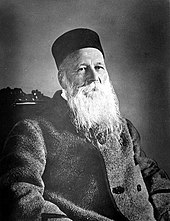
The highest accolade awarded to peace makers is the Nobel Prize in Peace, awarded since 1901 by the Norwegian Nobel Committee. It is awarded annually to internationally notable persons post-obit the prize's cosmos in the will of Alfred Nobel. According to Nobel's will, the Peace Prize shall be awarded to the person who "...shall take done the most or the best work for fraternity betwixt nations, for the abolitionism or reduction of standing armies, and for the holding and promotion of peace congresses."[22]
Rhodes, Fulbright and Schwarzman scholarships [edit]
In creating the Rhodes Scholarships for outstanding students from the Usa, Frg and much of the British Empire, Cecil Rhodes wrote in 1901 that 'the object is that an understanding between the iii groovy powers will return state of war incommunicable and educational relations make the strongest tie'.[23] This peace purpose of the Rhodes Scholarships was very prominent in the first half of the 20th century, and became prominent again in contempo years under Warden of the Rhodes House Donald Markwell,[24] a historian of idea about the causes of state of war and peace.[25] This vision profoundly influenced Senator J. William Fulbright in the goal of the Fulbright fellowships to promote international understanding and peace, and has guided many other international fellowship programs,[26] including the Schwarzman Scholars to China created by Stephen A. Schwarzman in 2013.[27]
Gandhi Peace Prize [edit]

The International Gandhi Peace Prize, named later on Mahatma Gandhi, is awarded annually past the Government of Republic of india. It was launched as a tribute to the ideals espoused by Gandhi in 1995 on the occasion of the 125th ceremony of his birth. This is an annual award given to individuals and institutions for their contributions towards social, economic and political transformation through non-violence and other Gandhian methods. The award carries Rs. 10 million in cash, convertible in any currency in the globe, a plaque and a citation. It is open to all persons regardless of nationality, race, creed or sex.
Student Peace Prize [edit]
The Pupil Peace Prize is awarded biennially to a student or a student system that has fabricated a significant contribution to promoting peace and human rights.
Civilization of Peace News Network [edit]
The Culture of Peace News Network, otherwise known simply every bit CPNN, is a United nations authorized interactive online news network, committed to supporting the global movement for a culture of peace.
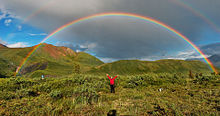
Rainbows: Often used as a symbol of harmony and peace.
Sydney Peace Prize [edit]
Every twelvemonth in the offset week of November, the Sydney Peace Foundation presents the Sydney Peace Prize. The Sydney Peace Prize is awarded to an organisation or an individual whose life and work has demonstrated significant contributions to:
The achievement of peace with justice locally, nationally or internationally
The promotion and attainment of human rights
The philosophy, linguistic communication and do of non-violence
Museums [edit]
A peace museum is a museum that documents historical peace initiatives. Many provide advocacy programs for irenic conflict resolution. This may include conflicts at the personal, regional or international level.
Smaller institutions include the Randolph Bourne Constitute, the McGill Middle East Programme of Civil Society and Peace Building and the International Festival of Peace Poetry..
Religious beliefs [edit]
Religious behavior ofttimes seek to place and address the basic problems of human life, including conflicts betwixt, amongst, and within persons and societies. In aboriginal Greek-speaking areas, the virtue of peace was personified equally the goddess Eirene, and in Latin-speaking areas as the goddess Pax. Her paradigm was typically represented by ancient sculptors every bit a total-grown woman, ordinarily with a horn of plenty and scepter and sometimes with a torch or olive leaves.
Christianity [edit]

The Kind Angel of Peace monument in the city of Donetsk, Ukraine, by Russian artist Peter Stronsky
Christians, who believe Jesus of Nazareth to exist the Jewish Messiah chosen Christ (meaning Anointed I),[28] interpret Isaiah ix:half-dozen as a messianic prophecy of Jesus in which he is chosen the "Prince of Peace."[29] In the Gospel of Luke, Zechariah celebrates his son John: And yous, child, volition be called prophet of the Nearly Loftier, for you will become before the Lord to ready his ways, to give his people cognition of salvation through the forgiveness of their sins, because of the tender mercy of our God by which the daybreak from on high will visit u.s.a. to shine on those who sit in darkness and death's shadow, to guide our anxiety into the path of peace.
As a testimony of peace, Churches of the Anabaptist Christian tradition (such as the Mennonites), besides Holiness Methodist Pacifists (such as the Immanuel Missionary Church building) and Quakers (such as the Conservative Friends), practise nonresistance and practise not participate in warfare.[30] [31]
In the Catholic Church, numerous pontifical documents on the Holy Rosary document a continuity of views of the Popes to accept conviction in the Holy Rosary equally a ways to foster peace. Subsequently, to the Encyclical Mense maio,1965, in which he urged the practice of the Holy Rosary, "the prayer so dear to the Virgin and and then much recommended by the Supreme Pontiffs," and every bit reaffirmed in the encyclical Christi Matri, 1966, to implore peace, Pope Paul VI stated in the churchly Recurrens mensis, October 1969, that the Rosary is a prayer that favors the great gift of peace.
Hinduism [edit]
Hindu texts incorporate the following passages:
May in that location be peace in the heavens, peace in the atmosphere, peace on the globe. Permit in that location be coolness in the water, healing in the herbs and peace radiating from the copse. Allow there be harmony in the planets and in the stars, and perfection in eternal cognition. May everything in the universe be at peace. Permit peace pervade everywhere, at all times. May I experience that peace inside my own eye.
Allow united states of america take concord with our own people, and concord with people who are strangers to us. Ashwins (Celestial Twins,) create between us and the strangers a unity of hearts. May nosotros unite in our minds, unite in our purposes, and not fight confronting the heavenly spirit within us. Let not the battle-cry ascent amidst many slain, nor the arrows of the war-god fall with the break of day
—Yajur Veda 7.52
A superior being does non render evil for evil. This is a saying one should observe... One should never harm the wicked or the proficient or even animals meriting decease. A noble soul will do compassion even towards those who savour injuring others or cruel deeds... Who is without fault?
The chariot that leads to victory is of another kind.
- Valour and fortitude are its wheels;
- Truthfulness and virtuous comport are its banner;
- Strength, discretion, self-restraint and benevolence are its four horses,
- Harnessed with the cords of forgiveness, pity and equanimity...
- Whoever has this righteous chariot, has no enemy to conquer anywhere.
—Valmiki, Ramayana
Buddhism [edit]
Buddhists believe that peace can exist attained once all suffering ends. They regard all suffering as stemming from cravings (in the farthermost, greed), aversions (fears), or delusions. To eliminate such suffering and achieve personal peace, followers in the path of the Buddha adhere to a set up of teachings called the Four Noble Truths — a cardinal tenet in Buddhist philosophy.
Islam [edit]
Islam derived from the root word salam which literally means peace. Muslims are chosen followers of Islam. Quran conspicuously stated "Those who take believed and whose hearts are bodacious past the remembrance of Allah. Unquestionably, by the remembrance of Allah, hearts are assured" and stated "O yous who have believed, when yous are told, "Space yourselves" in assemblies, and so brand space; Allah will make space for y'all. And when you lot are told, "Arise," then arise; Allah will raise those who have believed among you and those who were given knowledge, by degrees. And Allah is Acquainted with what y'all do."[32] [33]
Judaism [edit]
The Judaic tradition directly assembly God with peace, as evidenced by various principles and laws in Judaism. Shalom, the biblical and mod Hebrew word for peace, is one of the names for God according to the Judaic law and tradition. For case, in traditional Jewish law, individuals are prohibited from saying "Shalom" when they are in the bathroom as there is a prohibition on uttering any of God's names in the bathroom, out of respect for the divine name. Jewish liturgy and prayer is replete with prayers asking God to establish peace in the globe. The Shmoneh Esreh, a key prayer in Judaism that is recited 3 times each twenty-four hour period, concludes with a blessing for peace. The last blessing of the Shmoneh Esreh, likewise known as the Amida ("standing" as the prayer is said while standing), is focused on peace, commencement and ending with supplications for peace and blessings. Peace is fundamental to Judaism's core principle of Moshaich ("messiah") which connotes a time of universal peace and affluence, a time where weapons will be turned into plowshares and lions will sleep with lambs. As it is written in the Volume of Isaiah ii:4 and 11:half dozen-nine:
They shall shell their swords into plowshares and their spears into pruning hooks; nation will not lift sword against nation and they will no longer study warfare.[34]
The wolf will live with the lamb, the leopard will lie downwards with the goat, the calf and the king of beasts and the yearling together; and a petty child will lead them. The cow will feed with the deport, their immature will prevarication down together, and the lion will consume straw similar the ox. The infant volition play nearly the hole of the cobra, and the young child put his manus into the viper's nest. They will neither harm nor destroy on all my holy mountain, for the globe will be total of the knowledge of the Lord as the waters embrace the sea.[35]
This final metaphor from Tanakh (Hebrew bible) symbolizes the peace that a longed for messianic age will be characterized by, a peace where natural enemies, the strong and the weak, predator and prey, will live in harmony.
Jews pray for the messianic age of peace every day in the Shmoneh Esreh in improver to faith in the coming of the messianic historic period constituting 1 of the thirteen core principles of faith in Judaism, according to Maimonides.
Ideological behavior [edit]
Pacifism [edit]

A peace sign, which is widely associated with pacifism
Pacifism is the categorical opposition to the behaviors of state of war or violence every bit a ways of settling disputes or of gaining reward. Pacifism covers a spectrum of views ranging from the belief that international disputes can and should all be resolved via peaceful behaviors; to calls for the abolitionism of diverse organizations which tend to institutionalize aggressive behaviors, such as the war machine, or artillery manufacturers; to opposition to any arrangement of society that might rely in any way upon governmental strength. Such groups which sometimes oppose the governmental employ of forcefulness include anarchists and libertarians. Accented pacifism opposes trigger-happy beliefs under all circumstance, including defence force of self and others.
Pacifism may be based on moral principles (a deontological view) or pragmatism (a consequentialist view). Principled pacifism holds that all forms of vehement beliefs are inappropriate responses to conflict, and are morally wrong. Pragmatic pacifism holds that the costs of state of war and inter-personal violence are so substantial that improve ways of resolving disputes must be institute.
Inner peace, meditation and prayerfulness [edit]
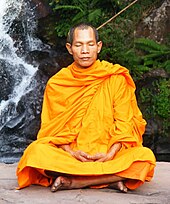
Buddhist monk during meditation near Phu Soidao Nationalpark.
Psychological or inner peace (i.e. peace of mind) refers to a state of being internally or spiritually at peace, with sufficient noesis and understanding to keep oneself calm in the face of apparent discord or stress. Being internally "at peace" is considered by many to be a healthy mental state, or homeostasis and to be the opposite of feeling stressful, mentally anxious, or emotionally unstable. Inside the meditative traditions, the psychological or inward achievement of "peace of mind" is ofttimes associated with bliss and happiness.
Peace of mind, repose, and calmness are descriptions of a disposition free from the effects of stress. In some meditative traditions, inner peace is believed to be a state of consciousness or enlightenment that may be cultivated by diverse types of meditation, prayer, t'ai chi ch'uan (太极拳, tàijíquán), yoga, or other various types of mental or physical disciplines. Many such practices refer to this peace as an feel of knowing oneself. An emphasis on finding one's inner peace is often associated with traditions such as Buddhism, Hinduism, and some traditional Christian contemplative practices such as monasticism,[36] also as with the New Age movement.
Non-Aggression Principle [edit]
The Non-Aggression Principle (NAP) asserts that aggression against an private or an individual's property is always an immoral violation of one's life, liberty, and belongings rights.[37] [38] Utilizing deceit instead of consent to achieve ends is too a violation of the Non-Aggression principle. Therefore, under the framework of the Not-Aggression principle, rape, murder, deception, involuntary taxation, government regulation, and other behaviors that initiate aggression against otherwise peaceful individuals are considered violations of this principle.[39] This principle is most usually adhered to past libertarians. A common lift pitch for this principle is, "Skillful ideas don't require force."[40]
Satyagraha [edit]
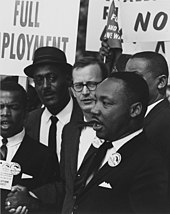
Satyagraha is a philosophy and practice of nonviolent resistance developed by Mohandas Karamchand Gandhi. He deployed satyagraha techniques in campaigns for Indian independence and also during his earlier struggles in South Africa.
The word satyagraha itself was coined through a public contest that Gandhi sponsored through the newspaper he published in South Africa, Indian Opinion, when he realized that neither the common, gimmicky Hindu linguistic communication nor the English language contained a word which fully expressed his own meanings and intentions when he talked nigh his nonviolent approaches to conflict. According to Gandhi's autobiography, the contest winner was Maganlal Gandhi (presumably no relation), who submitted the entry 'sadagraha', which Gandhi then modified to 'satyagraha'. Etymologically, this Hindic discussion ways 'truth-compactness', and is unremarkably translated equally 'steadfastness in the truth' or 'truth-force'.
Satyagraha theory also influenced Martin Luther King Jr., James Bevel, and others during the campaigns they led during the civil rights movement in the United States. The theory of satyagraha sees ways and ends as inseparable. Therefore, information technology is contradictory to endeavor to use violence to obtain peace. As Gandhi wrote: "They say, 'ways are, afterwards all, means'. I would say, 'means are, afterwards all, everything'. As the means so the end..."[41] A quote sometimes attributed to Gandhi, but also to A. J. Muste, sums information technology upward: "There is no fashion to peace; peace is the manner".
Monuments [edit]
The following are monuments to peace:
| Proper name | Location | Arrangement | Meaning | Paradigm |
|---|---|---|---|---|
| Japanese Peace Bell | New York City, NY | United nations | Globe peace |  |
| Fountain of Fourth dimension | Chicago, IL | Chicago Park District | 100 years of peace betwixt the U.s. and UK |  |
| Fredensborg Palace | Fredensborg, Denmark | Frederick Four | The peace between Denmark–Kingdom of norway and Sweden, subsequently Great Northern War which was signed three July 1720 on the site of the unfinished palace. |  |
| International Peace Garden | North Dakota, Manitoba | non-profit system | Peace between the US and Canada, World peace | 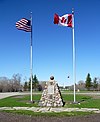 |
| Peace Arch | border between US and Canada, near Surrey, British Columbia. | not-profit organization | Congenital to honour the first 100 years of peace between Great Britain and the United States resulting from the signing of the Treaty of Ghent in 1814. | 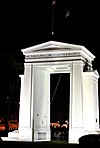 |
| Statue of Europe | Brussels | European Committee | Unity in Peace in Europe |  |
| Waterton-Glacier International Peace Park | Alberta, Montana | non-profit organization | World Peace | 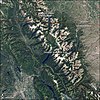 |
| Japanese Garden of Peace | Fredericksburg, Texas | National Museum of the Pacific War | A souvenir from the people of Nippon to the people of the U.s.a., presented to honor Chester W. Nimitz and created as a respite from the intensity of violence, devastation, and loss. |  |
| The Peace Dome | Windyville, MO | not-for-profit organization | Many minds working together toward a common ideal to create real and lasting transformation of consciousness on planet World. A place for people to come up together to learn how to live peaceably.[42] | |
| Shanti Stupa | Pokhara, Nepal | Nipponzan-Myōhōji-Daisanga | One of eighty peace pagodas in the World. |
Theories [edit]
Many different theories of "peace" exist in the earth of peace studies, which involves the study of de-escalation, conflict transformation, disarmament, and cessation of violence.[43] The definition of "peace" can vary with religion, culture, or subject of study.
Balance of power [edit]
The classical "realist" position is that the key to promoting society between states, and and then of increasing the chances of peace, is the maintenance of a balance of power between states – a situation where no state is and then dominant that information technology can "lay down the police force to the rest". Exponents of this view have included Metternich, Bismarck, Hans Morgenthau, and Henry Kissinger. A related approach – more than in the tradition of Hugo Grotius than Thomas Hobbes – was articulated by the so-chosen "English language school of international relations theory" such as Martin Wight in his book Ability Politics (1946, 1978) and Hedley Bull in The Anarchical Society (1977).
As the maintenance of a residual of power could in some circumstances require a willingness to go to war, some critics saw the thought of a residuum of power as promoting war rather than promoting peace. This was a radical critique of those supporters of the Allied and Associated Powers who justified entry into World War I on the grounds that information technology was necessary to preserve the residuum of ability in Europe from a German bid for hegemony.
In the second one-half of the 20th century, and especially during the cold war, a item class of residual of power – mutual nuclear deterrence – emerged as a widely held doctrine on the key to peace between the great powers. Critics argued that the development of nuclear stockpiles increased the chances of state of war rather than peace, and that the "nuclear umbrella" fabricated it "safe" for smaller wars (e.g. the Vietnam war and the Soviet invasion of Czechoslovakia to end the Prague Spring), then making such wars more likely.
Gratis trade, interdependence and globalization [edit]
It was a central tenet of classical liberalism, for example among English liberal thinkers of the tardily 19th and early on 20th century, that free merchandise promoted peace. For example, the Cambridge economist John Maynard Keynes (1883–1946) said that he was "brought up" on this thought and held it unquestioned until at to the lowest degree the 1920s.[44] During the economic globalization in the decades leading upwards to Earth War I, writers such as Norman Angell argued that the growth of economic interdependence between the great powers fabricated war between them futile and therefore unlikely. He fabricated this argument in 1913. A twelvemonth later Europe's economically interconnected states were embroiled in what would later go known as the First World War.[45]
These ideas have once again come to prominence amongst liberal internationalists during the globalization of the tardily 20th and early 21st century.[46] These ideas have seen commercialism as consistent with, fifty-fifty conducive to, peace.
Democratic peace theory [edit]
The democratic peace theory posits that democracy causes peace because of the accountability, institutions, values, and norms of democratic countries.[47]
Territorial peace theory [edit]
The territorial peace theory posits that peace causes democracy because territorial wars between neighbor countries pb to disciplinarian attitudes and disregard for democratic values.[48] [49] This theory is supported by historical studies showing that countries rarely become democratic until after their borders have been settled by territorial peace with neighbor countries.[l] [51]
State of war game [edit]
The Peace and War Game is an approach in game theory to sympathize the human relationship between peace and conflicts.
The iterated game hypotheses was originally used by academic groups and figurer simulations to study possible strategies of cooperation and assailment.[52]
Equally peace makers became richer over time, it became clear that making war had greater costs than initially anticipated. One of the well studied strategies that acquired wealth more than rapidly was based on Genghis Khan, i.e. a abiding aggressor making war continually to gain resource. This led, in contrast, to the development of what's known as the "provokable overnice guy strategy", a peace-maker until attacked, improved upon merely to win past occasional forgiveness even when attacked. By calculation the results of all pairwise games for each player, one sees that multiple players gain wealth cooperating with each other while haemorrhage a constantly aggressive histrion.[53]
Socialism and managed capitalism [edit]
Socialist, communist, and left-wing liberal writers of the 19th and 20th centuries (e.g., Lenin, J.A. Hobson, John Strachey) argued that capitalism acquired war (e.g. through promoting regal or other economic rivalries that lead to international conflict). This led some to argue that international socialism was the key to peace.
However, in response to such writers in the 1930s who argued that capitalism caused war, the economist John Maynard Keynes (1883–1946) argued that managed commercialism could promote peace. This involved international coordination of fiscal/budgetary policies, an international budgetary system that did not pit the interests of countries against each other, and a high degree of freedom of trade. These ideas underlay Keynes'southward work during Earth War 2 that led to the cosmos of the International Monetary Fund and the World Bank at Bretton Woods in 1944, and afterwards of the General Agreement on Tariffs and Trade (later the Globe Trade Organization).[54]
Justice and wholeness [edit]
Borrowing from the teachings of Norwegian theorist Johan Galtung, one of the pioneers of the field of Peace Inquiry, on 'Positive Peace',[55] and on the writings of Maine Quaker Gray Cox, a consortium of theorists, activists, and practitioners in the experimental John Woolman College initiative have arrived at a theory of "active peace". This theory posits in part that peace is part of a triad, which likewise includes justice and wholeness (or well-being), an interpretation consonant with scriptural scholarly interpretations of the pregnant of the early Hebrew give-and-take shalom. Furthermore, the consortium have integrated Galtung's teaching of the meanings of the terms peacemaking, peacekeeping, and peacebuilding, to also fit into a triadic and interdependent formulation or construction. Vermont Quaker John V. Wilmerding posits v stages of growth applicable to individuals, communities, and societies, whereby one transcends first the 'surface' awareness that nearly people have of these kinds of bug, emerging successively into acquiescence, pacifism, passive resistance, active resistance, and finally into active peace, dedicating themselves to peacemaking, peacekeeping or peace building.[56]
International organization and law [edit]
One of the near influential theories of peace, especially since Woodrow Wilson led the creation of the League of Nations at the Paris Peace Briefing of 1919, is that peace will exist advanced if the intentional anarchy of states is replaced through the growth of international law promoted and enforced through international organizations such as the League of Nations, the Un, and other functional international organizations. One of the most important early on exponents of this view was Alfred Eckhart Zimmern, for example in his 1936 book The League of Nations and the Rule of Law.[57]
Trans-national solidarity [edit]
Many "idealist" thinkers almost international relations – e.g. in the traditions of Kant and Karl Marx – have argued that the primal to peace is the growth of some form of solidarity between peoples (or classes of people) spanning the lines of cleavage between nations or states that pb to war.[58]
One version of this is the idea of promoting international understanding between nations through the international mobility of students – an idea most powerfully advanced by Cecil Rhodes in the creation of the Rhodes Scholarships, and his successors such as J. William Fulbright.[59]
Another theory is that peace tin can exist developed among countries on the basis of agile direction of water resource.[60]
Lyotard mail-modernism [edit]
Post-obit Wolfgang Dietrich, Wolfgang Sützl[61] and the Innsbruck School of Peace Studies, some peace thinkers have abandoned any single and all-encompassing definition of peace. Rather, they promote the idea of many peaces. They fence that since no singular, correct definition of peace can exist, peace should be perceived every bit a plurality. This mail service-modernistic understanding of peace(s) was based on the philosophy of Jean Francois Lyotard. Information technology served as a fundament for the more contempo concept of trans-rational peace(s) and elicitive disharmonize transformation.
In 2008, Dietrich enlarged his approach of the many peaces to the and so-chosen five families of peace interpretations: the energetic, moral, modern, post-modern and trans-rational arroyo.[62] Trans-rationality unites the rational and mechanistic understanding of modern peace in a relational and culture-based way with spiritual narratives and energetic interpretations.[63] The systemic understanding of trans-rational peaces advocates a client-centred method of conflict transformation, the so-chosen elicitive approach.[64]
Day [edit]
Peace day was founded as a twenty-four hours to recognize, award and promote peace. It is commemorated each year past United Nations members.
Studies, rankings, and periods [edit]
Peace and conflict studies [edit]

Peace and conflict studies is an academic field which identifies and analyses violent and irenic behaviours, as well as the structural mechanisms attention violent and non-violent social conflicts. This is to improve understand the processes leading to a more desirable human condition.[65] Ane variation, Peace studies (irenology), is an interdisciplinary effort aiming at the prevention, de-escalation, and solution of conflicts. This contrasts with war studies (polemology), directed at the efficient attainment of victory in conflicts. Disciplines involved may include political science, geography, economics, psychology, folklore, international relations, history, anthropology, religious studies, and gender studies, as well as a variety of other disciplines.
Measurement and ranking [edit]
Although peace is widely perceived every bit something intangible, diverse organizations accept been making efforts to quantify and measure it. The Global Peace Index produced by the Constitute for Economics and Peace is a known effort to evaluate peacefulness in countries based on 23 indicators of the absence of violence and absenteeism of the fear of violence.[66]
The last edition of the Alphabetize ranks 163 countries on their internal and external levels of peace.[67] According to the 2017 Global Peace Index, Iceland is the most peaceful country in the world while Syria is the least peaceful one.[68] Fragile States Index (formerly known as the Failed States Index) created past the Fund for Peace focuses on chance for instability or violence in 178 nations. This index measures how fragile a state is by 12 indicators and subindicators that evaluate aspects of politics, social economic system, and military facets in countries.[69] The 2015 Failed Country Index reports that the almost delicate nation is S Sudan, and the to the lowest degree fragile 1 is Finland.[70] Academy of Maryland publishes the Peace and Disharmonize Instability Ledger in order to measure peace. It grades 163 countries with 5 indicators, and pays the about attending to risk of political instability or armed conflict over a three-year menstruation. The most recent ledger shows that the most peaceful country is Slovenia on the contrary Afghanistan is the most conflicted nation. Likewise indicated to a higher place reports from the Institute for Economics and Peace, Fund for Peace, and University of Maryland, other organizations including George Mason University release indexes that rank countries in terms of peacefulness.
Long periods [edit]
The longest continuing period of peace and neutrality among currently existing states is observed in Sweden since 1814 and in Switzerland, which has had an official policy of neutrality since 1815. This was made possible partly by the periods of relative peace in Europe and the world known every bit Pax Britannica (1815–1914), Pax Europaea/Pax Americana (since 1950s), and Pax Atomica (likewise since the 1950s).
Other examples of long periods of peace are:
- the isolationistic Edo period (too known equally Tokugawa shogunate) in Nippon 1603 to 1868 (265 years)
- Pax Khazarica in Khazar Khanate (south-due east Turkey) about 700–950 AD (250 years)
- Pax Romana in the Roman empire (for 190 or 206 years).
Meet also [edit]
- Anti-state of war
- Catholic peace traditions
- Artistic Peacebuilding
- Grey-zone (international relations)
- Group on International Perspectives on Governmental Assailment and Peace (GIPGAP)
- Human overpopulation#Warfare and conflict over dwindling resources
- List of peace activists
- List of places named Peace
- List of peace prizes
- Moral syncretism
- Non-violent
- Not-assailment principle
- Peace pedagogy
- Peace in Islamic philosophy
- Peace Journalism
- Peace makers
- Peace One Day
- Peace Palace
- Peace symbol
- Perpetual peace
- Prayer for Peace
- Structural violence
- Sulh
- War resister
References [edit]
- ^ "United nations Logo and Flag". United nations.org. United Nations. Retrieved 10 Dec 2020.
- ^ "International Day of Peace 2020 Poster" (PDF). United nations.org. United nations. Retrieved ten December 2020.
- ^ Dalai Lama Fourteen: Quotable Quotes Archived 17 September 2017 at the Wayback Machine Goodreads. Downloaded 15 September 2017
- ^ Online Etymology Dictionary, "Peace" Archived 14 December 2013 at the Wayback Machine.
- ^ Benner, Jeff: Ancient Hebrew Research center: http://www.ancient-hebrew.org/27_peace.html Archived 26 April 2014 at the Wayback Motorcar
- ^ "Peace Sign". Inner Peace Zone . Retrieved 17 Dec 2021.
{{cite web}}: CS1 maint: url-status (link) - ^ The Cambridge Aboriginal History, edited by John Boederman, Cambridge Academy Press, 1997, pg 832
- ^ Mycenaean Origin of Greek Mythology, Martin Nilsson, 1983 Univ of California Press, p. 48.
- ^ Amelia Dowler, Curator, British Museum; A History of the Globe; http://world wide web.bbc.co.great britain/ahistoryoftheworld/objects/7cEz771FSeOLptGIElaquA
- ^ Šmihula, Daniel (2013): The Employ of Forcefulness in International Relations, p. 129, ISBN 978-80-224-1341-1.
- ^ "The Theory of Active Peace". internationalpeaceandconflict.org. Archived from the original on 25 July 2015.
- ^ "Protect Heritage Now for Resilience and Peace".
- ^ "UNESCO Legal Instruments: 2nd Protocol to the Hague Convention of 1954 for the Protection of Cultural Property in the Effect of Armed Conflict 1999".
- ^ UNESCO convenes Libyan and international experts meeting for the safeguard of Libya's cultural heritage. UNESCO World Heritage Center - News, 21. Oktober 2011; Roger O'Keefe, Camille Péron, Tofig Musayev, Gianluca Ferrari "Protection of Cultural Property. War machine Manual." UNESCO, 2016, p 73; Eric Gibson: The Destruction of Cultural Heritage Should be a War Criminal offense. In: The Wall Street Journal, 2 March 2015; UNESCO Manager-General calls for stronger cooperation for heritage protection at the Bluish Shield International General Assembly. UNESCO, xiii September 2017.
- ^ "UNIFIL - Activeness plan to preserve heritage sites during disharmonize, 12 Apr 2019".
- ^ "Austrian Military Mission in Lebanon" (in German).
- ^ Jyot Hosagrahar: Civilization: at the centre of SDGs. UNESCO-Kurier, April-Juni 2017; Rick Szostak: The Causes of Economic Growth: Interdisciplinary Perspectives. Springer Science & Concern Media, 2009, ISBN 9783540922827.
- ^ "The Function and Responsibilities of the Law" (PDF). Policy Studies Institute. p. xii. Retrieved 22 Dec 2009.
- ^ Lioe, Kim Eduard (3 Dec 2010). Armed Forces in Police Enforcement Operations? – The High german and European Perspective (1989 ed.). Springer-Verlag Berlin Heidelberg. pp. 52–57. ISBN978-3-642-15433-ane.
- ^ Romm, Joseph J. (1993). Defining national security: the nonmilitary aspects. Pew Projection on America'south Task in a Changed Globe (Pew Projection Series). Council on Strange Relations. p. 122. ISBN978-0-87609-135-7 . Retrieved 22 September 2010.
- ^ a b Rogers, P (2010). Losing control : global security in the xx-beginning century (3rd ed.). London: Pluto Press. ISBN9780745329376. OCLC 658007519.
- ^ "Excerpt from the Will of Alfred Nobel". Nobel Foundation. Archived from the original on 26 October 2007. Retrieved 31 March 2008.
- ^ "Archived copy" (PDF). Archived from the original (PDF) on ix June 2013. Retrieved 9 June 2013.
{{cite web}}: CS1 maint: archived copy equally title (link) - ^ Cecil Rhodes'due south goal of Scholarships promoting peace highlighted – The Rhodes Scholarships Archived 22 September 2013 at the Wayback Machine. Diverse materials on peace by Warden of the Rhodes House Donald Markwell in Markwell, "Instincts to Atomic number 82": On Leadership, Peace, and Education. Connor Courtroom, 2013.
- ^ East.g., Donald Markwell, John Maynard Keynes and International Relations: Economic Paths to War and Peace. Oxford: Oxford University Press, 2006.
- ^ http://www.politics.ox.ac.great britain/materials/news/Fulbright_18May12_Arndt.pdf Archived 22 September 2013 at the Wayback Machine, "Archived copy". Archived from the original on 22 September 2013. Retrieved 26 September 2012.
{{cite web}}: CS1 maint: archived copy every bit title (link) - ^ See, e.g., "The Rhodes Scholarships of China" in Donald Markwell, "Instincts to Pb": On Leadership, Peace, and Teaching, Connor Court, 2013.
- ^ Benner, Jeff: Aboriginal Hebrew Inquiry Centre:http://www.aboriginal-hebrew.org/27_messiah.html Archived 26 April 2014 at the Wayback Motorcar>
- ^ "For to us a child is born, to u.s. a son is given, and the regime will exist on his shoulders. And he will be called Wonderful Counselor, Mighty God, Everlasting Father, 'Prince of Peace'." [New International Version]
- ^ Beaman, Jay; Pipkin, Brian 1000. (2013). Pentecostal and Holiness Statements on War and Peace. Wipf and Stock Publishers. pp. 98–99. ISBN9781610979085.
- ^ "Article 22. Peace, Justice, and Nonresistance". Mennonite Church USA. Retrieved 4 June 2021.
- ^ "peaceful quran". Archived from the original on 9 May 2016. Retrieved 22 April 2016.
- ^ "peaceful quran". Archived from the original on ix May 2016. Retrieved 22 April 2016.
- ^ Isaiah ii:4
- ^ Isaiah xi:vi–nine
- ^ Essential Writings of Christian Mysticism Page 163. 2006. By Bernard McGinn.
- ^ "For Libertarians, At that place Is Only 1 Cardinal Right". 29 March 2015.
- ^ ""The Morality of Libertarianism"". 1 October 2015.
- ^ "The Non-Aggression Precept of Libertarianism". Lew Rockwell. Retrieved 22 March 2016.
- ^ """Good ideas don't require forcefulness"". four July 2021.
- ^ R.Yard. Prabhu & U.R. Rao, editors; from department "The Gospel Of Sarvodaya" Archived 27 September 2011 at the Wayback Car, of the volume The Heed of Mahatma Gandhi Archived 20 Dec 2010 at the Wayback Machine, Ahemadabad, India, Revised Edition, 1967.
- ^ "The Peace Dome History". peacedome.org. Archived from the original on two February 2014. Retrieved eighteen January 2014.
- ^ einaudi.cornell.edu Archived 22 Oct 2007 at the Wayback Machine
- ^ Quoted from Donald Markwell, John Maynard Keynes and International Relations: Economic Paths to State of war and Peace. Oxford: Oxford University Printing, 2006, chapter 2.
- ^ "NATO Review - the cease of the "Great Illusion": Norman Angell and the founding of NATO". 14 January 2019.
- ^ For sources, meet articles on liberalism and classical liberalism.
- ^ Hegre, Håvard (2014). "Democracy and armed conflict". Journal of Peace Inquiry. 51 (2): 159–172. doi:10.1177/0022343313512852.
- ^ Gibler, Douglas M.; Hutchison, Marc 50.; Miller, Steven V. (2012). "Individual identity attachments and international conflict: The importance of territorial threat". Comparative Political Studies. 45 (12): 1655–1683.
- ^ Hutchison, Marc L.; Gibler, Douglas K. (2007). "Political tolerance and territorial threat: A cross-national written report". The Periodical of Politics. 69 (1): 128–142.
- ^ Gibler, Douglas M.; Owsiak, Andrew (2017). "Republic and the Settlement of International Borders, 1919-2001". Journal of Conflict Resolution. 62 (9): 1847–1875.
- ^ Owsiak, Andrew P.; Vasquez, John A. (2021). "Peaceful dyads: A territorial perspective". International Interactions. 47 (6): 1040–1068. doi:10.1080/03050629.2021.1962859.
- ^ Shy, O., 1996, Industrial Organization: Theory and Applications, Cambridge, Mass.: The MIT Press.
- ^ North.R. Miller, "Nice Strategies Finish First: A Review of The Evolution of Cooperation", Politics and the Life Sciences, Clan for Politics and the Life Sciences, 1985.
- ^ . See Donald Markwell. John Maynard Keynes and International Relations: Economic Paths to War and Peace. Oxford: Oxford University Printing, 2006.
- ^ Galtung, J: Peace by peaceful means: peace and conflict, development and civilization, folio 32. Sage Publications, 1996.
- ^ Wilmerding, John. "The Theory of Active Peace". Archived from the original on 20 June 2009. Retrieved vii February 2010.
- ^ Macmillan, 1936.
- ^ See, e.g., Sir Harry Hinsley. Power and the Pursuit of Peace, Cambridge: Cambridge University Press, 1962.
- ^ Discussed above. Come across, eastward.g., Donald Markwell. "Instincts to Lead": On Leadership, Peace, and Instruction (2013).
- ^ "Publications – Strategic Foresight Group, Recall Tank, Global Policy, Global diplomacy research, Water Disharmonize studies, global policy strategies, strategic policy group, global futurity studies". strategicforesight.com. Archived from the original on ane Nov 2016. Retrieved ii Nov 2016.
- ^ Wolfgang Dietrich/Wolfgang Sützl: A Call for Many Peaces; in: Dietrich, Wolfgang, Josefina Echavarría Alvarez, Norbert Koppensteiner eds.: Key Texts of Peace Studies; LIT Münster, Vienna, 2006
- ^ Wolfgang Dietrich: Interpretations of Peace in History and Culture; Palgrave Macmillan, London, 2012
- ^ Wolfgang Dietrich, Josefina Echavarría Alvarez, Gustavo Esteva, Daniela Ingruber, Norbert Koppensteiner eds.: The Palgrave International Handbook of Peace Studies. A Cultural Approach; Palgrave MacMillan London, 2011
- ^ John Paul Lederach: Preparing for Peace; Syracuse University Press, 1996
- ^ Dugan, 1989: 74
- ^ "Vision of Humanity". visionofhumanity.org. Archived from the original on 22 February 2011. Retrieved 15 Dec 2013.
- ^ Jethro Mullen (25 June 2015). "Study: Republic of iceland is the most peaceful nation in the world". CNN.com. Archived from the original on 7 August 2015. Retrieved vi August 2015.
- ^ "These are the most peaceful countries in the world". Earth Economical Forum. Archived from the original on 15 July 2017. Retrieved 14 July 2017.
- ^ "Fragile States 2014". foreignpolicy.com. Foreign Policy. Archived from the original on 17 March 2017. Retrieved ten March 2017.
- ^ "South Sudan Tops List of Globe'south Delicate States – Again". VOA. Archived from the original on thirteen August 2015. Retrieved 6 August 2015.
Notes [edit]
- Sir Norman Angell. The Great Illusion. 1909
- Raymond Aron, Peace and War. London: Weidenfeld & Nicolson, 1966
- Hedley Balderdash. The Anarchical Social club. Macmillan, 1977
- Sir Herbert Butterfield. Christianity, Diplomacy and State of war. 1952
- Martin Ceadel. Pacifism in Britain, 1914–1945: The Defining of a Faith. Oxford: Clarendon Press, 1980
- Martin Ceadel. Semi-Discrete Idealists: The British Peace Move and International Relations, 1854–1945. Oxford: Oxford University Press, 2000.
- Martin Ceadel. The Origins of War Prevention: The British Peace Movement and International Relations, 1730–1854. Oxford: Oxford University Press, 1996
- Martin Ceadel. Thinking most Peace and War. Oxford: Oxford University Press, 1987
- Inis L. Claude, Jr. Swords into Ploughshares: The Problems and Progress of International Organization. 1971
- Michael W. Doyle. Means of War and Peace: Realism, Liberalism, and Socialism. W.Westward. Norton, 1997
- Sir Harry Hinsley. Power and the Pursuit of Peace. Cambridge: Cambridge University Printing, 1962
- Andrew Hurrell. On Global Society. Oxford: Oxford University Press, 2008
- Immanuel Kant. Perpetual Peace. 1795
- Donald Markwell. John Maynard Keynes and International Relations: Economic Paths to War and Peace. Oxford: Oxford Academy Press, 2006.
- Donald Markwell. "Instincts to Pb": On Leadership, Peace, and Didactics. Connor Court, 2013
- Hans Morgenthau. Politics Among Nations. 1948
- Steven Pinker. The Meliorate Angels of Our Nature: Why Violence Has Declined. Viking, 2011
- Sir Alfred Eckhard Zimmern. The League of Nations and the Dominion of Law. Macmillan, 1936
- Kenneth Waltz. Man, the State and War. Princeton: Princeton Academy Press, 1978
- Michael Walzer. Just and Unjust War. Basic Books, 1977
- J. Whalan. How Peace Operations Piece of work. Oxford University Press, 2013
- Martin Wight. Ability Politics. 1946 (2nd edition, 1978)
- Letter from Birmingham Jail by Rev. Martin Luther Rex Jr.
- "Pennsylvania, A History of the Commonwealth," esp. pg. 109, edited past Randall M. Miller and William Pencak, The Pennsylvania State Academy Press, 2002
- Peaceful Societies, Alternatives to Violence and War Curt profiles on 25 peaceful societies.
- The Path to Peace, by Laure Paquette
- Prefaces to Peace: a Symposium [i.e. anthology], Consisting of [works by] Wendell L. Willkie, Herbert Hoover and Hugh Gibson, Henry A. Wallace, [and] Sumner Welles. "Cooperatively published past Simon and Schuster; Doubleday, Doran, and Co.; Reynal & Hitchcock; [and] Columbia Academy Printing", [194-]. xii, 437 p.
External links [edit]
- Carnegie Endowment for International Peace
- Lemonade a la Carnegie accessed 16 Oct 2012
- Research Guide on Peace by the United Nations Library at Geneva
- PeaceWiki
- Peace Monuments Around the Earth
- Peace at Curlie
- Working Group on Peace and Evolution (FriEnt)
- Answers to: "How do nosotros achieve world peace?"
- World Brotherhood of Religions Peace Summit (WARP Summit)
Source: https://en.wikipedia.org/wiki/Peace
0 Response to "According to Google, in What Year Will Humans Finally Live in Peace?"
Post a Comment